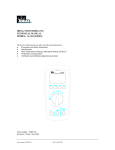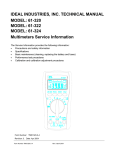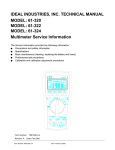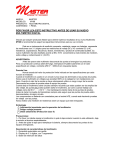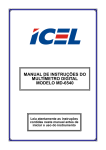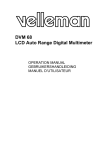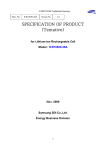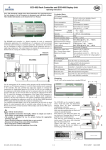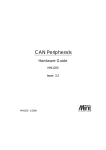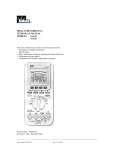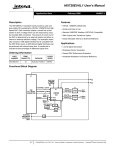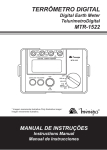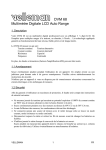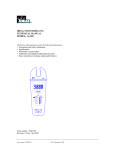Download IDEAL INDUSTRIES, INC. TECHNICAL MANUAL MODEL: 61-350
Transcript
IDEAL INDUSTRIES, INC. TECHNICAL MANUAL MODEL: 61-350 The Service Information provides the following information: ● Precautions and safety information ● Specifications ● Basic maintenance (cleaning, replacing the battery and fuses) ● Performance test procedures ● Calibration and calibration adjustment procedures Form Number: TM61350 Revision: 2. Date: July 2006 Form Number TM61350 Rev 2 July 2006 TABLE OF CONTENTS Title Page Introduction Precautions and Safety Information 1 1 Symbols 1 Safety 2 Specifications 3 General Specification 3 Measurement Characteristics 4 Voltage Specification 4 Resistance, Diode Specifications 4/5 Auto Power Off 5 Disable Auto Power Off 5 Physical and environment characteristics 6 Certification and compliance 6 Required Equipment 7 Basic Maintenance 8 Opening the Meter Case 8 Replacing the Battery 8 Performance Tests 9 Testing the Display 9 Testing the Voltage Function 10 Testing the Resistance Function 11 Checking the Diode Test Function 11 Calibration 12 DCV Calibration 12 ACV Calibration 12 Calibration Adjustment Points 13 Form Number TM61350 Rev 2 July 2006 Page 1 Introduction Warning To avoid shock or injury, do not perform the verification tests or calibration procedures described in the manual unless you are qualified to do so. The information provided in this document is for the use of qualified personnel only. Caution The 61-350 serials contain parts that can be damaged by static discharge. Follow the standard practices for handling static sensitive devices. For additional information about IDEAL INDUSTRIES, INC. and its products, and services, visit IDEAL INDUSTRIES, INC. web site at: www.idealindustries.com Precautions and Safety Information Use the Meter only as described in the Service Manual. If you do not do so, the protection provided by the Meter may be impaired. Read the “Safety Information” page before servicing this product. In this manual, a Warning identifies conditions and actions that pose hazard (s) to the user; a Caution identifies conditions and actions that may damage the Meter or the test instruments. The Symbols The symbols used on the Meter and in this manual are explained in Table A. Table A. The Symbols Risk of electric shock See instruction card for details DC measurement Equipment protected by double or reinforced insulation Battery Earth AC measurement Conforms to EU directives Form Number TM61350 Rev 2 July 2006 Page 2 SAFETY Review the following safety precautions to avoid injury and prevent damage to this product or any products connected to it. To avoid potential hazards, use the product only as specified. CAUTION These statements identify conditions or practices that could result in damage to the equipment or other property. WARNING These statements identify conditions or practices that could result in personal injury or loss of life. Specific precautions Use proper Fuse. To avoid fire hazard, use only the fuse type and rating specified for this product. Do not operate without covers. To avoid personal injury, do not apply any voltage or current to the product without covers in place. Electric overload. Never apply a voltage to a connector on the product that is outside the range specified for that connector. Avoid electric shock. To avoid injury or loss of life, do not connect or disconnect probes or test leads while they are connected to a voltage source. Do not operate in wet/damp conditions. To avoid electric shock, do not operate this product in wet or damp conditions. Form Number TM61350 Rev 2 July 2006 Page 3 SPECIFICATIONS All specifications are warranted unless noted typical and apply to the 61-350. Stated accuracies are at 23°C±5°C at less than 80% relative humidity and without the battery indicator displayed. General specifications Characteristics Display count Numeric update rate Polarity display Overrange display Low voltage indicator Automatic power-off time Power source Maximum input voltage Maximum floating voltage V connector Temperature Coefficient Battery Life Form Number TM61350 Description 3 1/2 1.5 times / sec Automatic “OL” is display is indicated Automatic backlit off = 10 minutes 1.5V×2 batteries 600V CAT III between V and COM 600V CAT III between any terminal and earth ground V , V , Ω, , 0.2×(Spec. Accuracy) / °C, <18°C or >28°C Alkaline 1.5V×2 AAA size 220 hours Rev 2 July 2006 Page 4 Measurement Characteristics Accuracy is ±(% reading + number of digits) at 23°C ± 5°C, less than 80% R.H. (1) DC Volts Range Resolution 200mV 100µV 2V 1mV 20V 10mV 200V 100mV Accuracy Over voltage protection ±(0.5% reading + 2 digits) DC 1000V 1000V 1V Input Impedance: 10MΩ (over 1000MΩ in 200mV range). (2) AC Volts Range Resolution Accuracy 200mV 0.1mV Unspecified 2V 1mV 20V 10mV 200V 100mV ±(1.5% reading + 5 digits) Over voltage protection 750V rms 750V 1V Input Impedance: 10MΩ // less than 100pF. Frequency Response: 50Hz~500Hz AC Conversion Type: AC conversions are ac-coupled true rms responding, calibrated to the rms value sine wave input. (3) Resistance Range Resolution 200Ω 0.1Ω 2KΩ 1Ω 20KΩ 10Ω 200KΩ 100Ω 2MΩ 1KΩ 20MΩ* 10KΩ Open circuit Voltage: -1.3V approx. * <100 dgt of reading rolling. Form Number TM61350 Accuracy Over voltage protection ±(0.7% reading + 3 digits) 600V rms ±(1.0% reading + 3 digits) ±(1.5% reading + 3 digits) Rev 2 July 2006 Page 5 (4) Diode Check and Continuity Range Resolution Accuracy Max. Test Current Max. Open Circuit Voltage 10mV ±(1.5% reading + 5 digits)* 1.5mA 2V * For 0.4V ~ 0.8V Overload Protection: 600V rms max. Continuity: Built-in buzzer sounds when measured resistance is less than 270Ω and sound off when measured resistance is more than >850Ω Between 270Ω to 850Ω the buzzer maybe sound or off either. (5) Auto Power Off (APO) If the meter idles for more than 10 minutes, the meter automatically turns the power off. When this happens, the state (non-logic measurement) of the meter is saved; the meter can be turned back on by pressing any switch or changing the rotary switch. If the meter is Re-Powered by pressing a switch, the LCD display the saved state, press the Hold switch to disable the hold state. The meter will alarm 15 seconds before automatically turning power off, any key press or rotary change will reset Auto-PowerOff. (6) Disable Auto Power Off In order to disable auto power off function, power up the meter while pressing down any switch other than the “Hold” and “NCV” switch. Form Number TM61350 Rev 2 July 2006 Page 6 Physical and Environmental Characteristics Characteristics Description Dimensions (H×W×D) 2.9 Inch×6.14 Inch×1.34 Inch (without holster) 3.15 Inch×6.45 Inch×1.73 Inch (with holster) Weight (with battery) 0.25Kg With holster 0.35Kg Environmental characteristics Description Temperature operating 0 to +50°C Non-Operating -20 to +60°C Humidity (operating) <80% R.H. Altitude Operating 2,000M (6560 ft.) Non-Operating 12,300M (40354 ft.) Vibration & shock Operating MIL-T-28800E TYPE II Class 5 2.66gRMS, 5 to 500Hz, 3axes (10 minutes each) Indoor Use Indoor Use Certifications and compliances Safety Input rating Designed to ICE 1010-1, UL3111-1 and CSA specifications V / Ω: Category III 600 Volts V / Ω: Category II 1000 Volts CAT III: Distribution level mains, fixed installation. Over voltage category CAT II: Local level mains, appliances, portable equipment CAT I: Signal level, special equipment or parts of equipment, telecommunication, electronics. Pollution Degree 2 Do not operate in environments where conductive Pollutants may be present. EC Declaration of Conformity Meets the intent of Directive 89/336/EEC for Electromagnetic Compatibility and Low Voltage Directive 73/23/EEC for product safety. Compliance was demonstrated to the following specifications as listed in the official Journal of the European Communities: En 55011 Class A: Radiated and Conducted Emissions. En 50082-1 Immunity: IEC 801-2 Electrostatic Discharge IEC 801-3 RF Radiated En 61010-1 Safety requirements for electrical equipment for measurement, control, and laboratory use. Form Number TM61350 Rev 2 July 2006 Page 7 Required Equipment Required equipment is listed in Table B. If the recommended models are not available, equipment with equivalent specifications may be used. Repairs or servicing should be performed only by qualified personnel. Table B. Required Equipment Equipment Calibrator Required Characteristics AC Voltage Range: 0 ~ 750V AC Accuracy: ±0.07% (Basic) Frequency Range: 40 ~ 1KHz Accuracy: ±2% DC Voltage Range: 0 ~ 1000V DC Accuracy: ±0.006% (Basic) Current Range: 0 ~ 10A Accuracy: AC (40Hz to 1KHz): ±0.08% (Basic) DC: ±0.02% (Basic) Frequency Source: 5.00Hz ~ 100MHz Accuracy: ±0.001% Amplitude: 0.5V p-p ~ 1.0V p-p (square wave) Accuracy: ±5% Resistance Range: 1Ω ~ 100MΩ Accuracy: ±0.03% (Basic) Capacitance Range: 1pF ~ 10mF Accuracy: ±0.10% (Basic) Form Number TM61350 Rev 2 July 2006 Recommended Model Fluke 5500 or Wavetek 9100 Calibrator or equipment Page 8 Basic Maintenance Warning To avoid shock, remove the test leads and any input signals before opening the case or replacing the battery or fuses. Opening the Meter Case Caution To avoid unintentional shock, always place the uncovered Meter assembly on a protective surface. When the case of the Meter is open, circuit connections are exposed. To open the Meter case, refer to Figure 1 and do the following: 1. Disconnect test leads from any live source, turn the rotary switch to OFF, and remove the test leads from front terminals. 2. Remove the battery door by using a Phillips-head screwdriver to turn the battery door screws counter-clockwise. 3. The case bottom is secured to the case top by four screws. Using a Phillips-head screwdriver, remove the four screws. Replacing the Battery The Meter is powered by 1.5V x 2 batteries. Figure 1 Form Number TM61350 Rev 2 July 2006 Page 9 Performance Tests The following performance tests verify the complete operability of the Meter and check the accuracy of each Meter function against the Meter’s specifications. Accuracy specifications are valid for a period of one year after calibration, when measured at an operating temperature of 18°C to 28°C and a maximum of 80% relative humidity. To perform the following tests, it is not necessary to open the case, no Adjustments are necessary, merely make the required connections, apply the designated inputs, determine if the reading on the Meter display falls within the acceptable range indicated. If the Meter fails any of these tests, it needs calibration adjustment or repair. Testing the Display Press “HOLD” key while turning the Meter on from the “OFF” position to hold the display in the Display Test Mode. Compare the display with the example in Figure 2. Turn off the meter to escape the test mode. LCD Graphics 61-350 Figure 2 Display Test Form Number TM61350 Rev 2 July 2006 Page 10 Testing the Voltage Function To verify accuracy in the AC and DC voltage ranges, do the following: 1. Turn the rotary switch to “V ” position. 2. Connect the Calibrator to the VΩ and COM inputs on the Meter. 3. Set the Calibrator for the voltage and frequency from step 1 to 8 in Table 1. 4. Compare the reading on the Meter display with the display reading shown in Table 1. 5. If the display reading falls outside of the range shown in Table 1, the Meter does not meet specification. Table 1 AC Voltage Test: Step Input Frequency Reading 1 1.500V 50Hz 1.472V to 1.528V 2 1.500V 300Hz 1.472V to 1.528V 3 15.00V 50Hz 14.72V to 15.28V 4 15.00V 500Hz 14.72V to 15.28V 5 150.0V 50Hz 147.2V to 152.8V 6 150.0V 500Hz 147.2V to 152.8V 7 750V 50Hz 734V to 766V 8 750V 500Hz 734V to 766V 6. Turn the rotary switch to “V ” position. 7. Set the calibration for the voltage from step 1 to 6 in Table 2. 8. Compare the reading on the Meter display with the display reading shown in Table 2. 9. If the display reading falls outside of the range shown in Table 2, the meter does not meet specification. Table 2 DC Voltage Test: Form Number TM61350 Step Input Reading 1 150.0mV 149.0V to 151.0V 2 -150.0mV -149.0V to -151.0V 3 1.500V 1.490V to 1.510V 4 15.00V 14.90V to15.10V 5 150.0V 149.0V to 151.0V 6 990V 983V to 997V Rev 2 July 2006 Page 11 Testing the Resistance Function To verify the accuracy of the resistance function, do the following: 1. Connect the Calibrator to VΩ and COM on the Meter. 2. Turn the rotary switch to Ω. 3. Apply the inputs for step 1-6 in Table 3. 4. Compare the Meter display readings to the display readings in Table 3. 5. If the display reading falls outside of the range shown in Table 3, the Meter does not meet specification. Table 3 Ω Resistance Test : Step Source Reading 1 150.0Ω 148.6Ω to 151.4Ω 2 1.500KΩ 1.486KΩ to 1.514KΩ 3 15.00KΩ 14.86KΩ to 15.14KΩ 4 150.0KΩ 148.6KΩ to 151.4KΩ 5 1.500MΩ 1.482MΩ to 1.518MΩ 6 15.00MΩ 14.74MΩ to 15.26MΩ Lead resistance on the 200Ω range is not included in error. Checking the Diode Test Function To check the diode test function, do the following: 1. Connect the Calibrator to the VΩ and COM inputs on the Meter. 2. Turn the rotary switch to . 3. Apply .5V DC. The meter display should read approx. .5V dc. 4. Built-in buzzer sounds when measured resistance is less than 270Ω and sound off when measured resistance is more than >850Ω Between 270Ω to 850Ω the buzzer maybe sound or off either. Form Number TM61350 Rev 2 July 2006 Page 12 Calibration Procedure Recalibrate your meter: It is recommended that the multimeter be calibrated once each year. 1. Perform calibration at an ambient temperature of 23°C±2°C and a relative humidity of 75% or less. 2. Disconnect the test leads and turn the meter off. Remove the test leads from the front terminals. 3. Position the meter face down. Remove the four screws from the case bottom. 4. Remove the case bottom. (A) DCV Calibration (Adjust VR2) (Refer to Figure 3) 5. Set the circuit board rotary switch "arrow" to the "V " position of circuit board. 6. Set the output of DC calibrator for 150.0V±0.02% and connect to VΩ and COM input terminals on meter. 7. Using a small flat-tipped screwdriver adjust the potentiometer VR2 until the display reads 149.9 to 150.1. 8. Disconnect the DC calibrator from the meter. (B) ACV Calibration (Adjust VR1) (Refer to Figure 3) 9. Set the circuit board rotary switch "arrow" to the "V " position of circuit board. 10. Set the output of AC calibration for 150.0V 100Hz and connect to VΩ and COM input terminals on meter. 11. Using a small flat-tipped screwdriver adjust the potentiometer VR1 until the display reads 149.9 to 150.1. 12. Disconnect the AC calibrator from the meter. Form Number TM61350 Rev 2 July 2006 Page 13 VR2 VR1 Figure 3 61-350 Calibration Adjustment Points Form Number TM61350 Rev 2 July 2006















